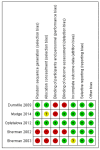Maggot Therapy in Wound Healing: A Systematic Review
- PMID: 32825736
- PMCID: PMC7504313
- DOI: 10.3390/ijerph17176103
Maggot Therapy in Wound Healing: A Systematic Review
Abstract
Background: It is estimated that 2% of the population in developing countries suffer from a chronic wound, making it a hidden phenomenon that is increasing as populations age. The ease of access to maggot therapy has made it increasingly attractive for implementation. This study aimed to explore the effectiveness of maggot therapy as compared to hydrogel dressings in the healing of chronic wounds.
Methods: An electronic literature search until October 2019 was performed using Medline, Embase, and Cumulative Index of Nursing and Allied Health Literature. The eligibility criteria were chronic wound patients with an intervention that involved a comparison of any maggot species with hydrogel dressings.
Results: The full text of five studies, involving 580 patients with chronic wounds, was retrieved. Four studies used the Lucilia sericata species. The maggot therapy facilitated faster and more effective debridement of non-viable tissue. It enabled faster development of granulation tissue and increased reduction in the wound surface area compared to hydrogel dressings. Maggot therapy had no effect on disinfection or complete healing rate for the wound.
Conclusion: Maggot therapy should be considered for faster wound debridement, granulation tissue development, and wound surface area reduction as well as in surgical contraindications. This review can be used as a guide to assist clinicians in identifying patients who may benefit from maggot therapy.
Keywords: disinfection; granulation tissue; hydrogel dressings; maggots; pain; wounds.
Conflict of interest statement
The authors declare no conflict of interests.
Figures
References
-
- Hirshmann R. Share of Population Older than 65 Years in Malaysia from 2015 to 2018. [(accessed on 17 September 2019)]; Available online: https://www.statista.com/statistics/713529/malaysia-aging-population.
Publication types
MeSH terms
LinkOut - more resources
Full Text Sources




